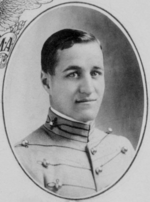Ralph Royce
Ralph Royce (28 June 1890 – 7 August 1965) was a United States Army Air Forces general during World War II. A West Point graduate who learned to fly in 1915–16, he served with the 1st Aero Squadron in the Pancho Villa Expedition and later led it on the Western Front. During World War II as a brigadier general, he led the Royce special mission to Mindanao, in which a small force of bombers flew from Australia to attack Japanese targets in the Philippines. Later he was Deputy Commander of the Ninth Air Force and commanded the 1st Provisional Tactical Air Force.
Early life

Ralph Royce was born in
World War I

Royce was posted to the 1st Aero Squadron,[1] which was then serving on the Mexican border in support of the Pancho Villa Expedition.[5] He briefly commanded the squadron in March 1917,[5] before being promoted to captain in May 1917.[1] In August 1917, he assumed command of the squadron again, taking it to the Western Front.[5] There, he was promoted to major in June 1918 and lieutenant colonel in August as commander of the 1st Observation Group.[1]
For his service in France, he was awarded the Croix de Guerre with the citation: "Commanding the 1st American Observation Escadrille, he insisted on making the first reconnaissance above the enemy lines himself. Gives to his pilots generally an example of admirable dash and intrepidity."[6]
Between the wars
Royce experienced the chaotic ups and downs in rank common to Regular officers in 1920, when the National Defense Act of 1920 reorganized the military. He first reverted to his permanent rank of captain of Infantry 1 March 1920 when his temporary ranks expired. On 1 July 1920, when the Air Service became a combatant arm of the line, he formally transferred to the branch, with promotion to major by virtue of a provision in the Act that allowed officers who earned their rank in service with the AEF to retain it. On 18 December 1922 he was discharged when Congress set a new ceiling on the number of majors authorized the Air Service, and reappointed as a captain, then promoted again to major on 11 July 1923.[1]
From 1920 to 1926 he was commanding officer of the primary flying school at
In January 1930 Royce commanded the 1st Pursuit Group in a flight across the northern United States from Selfridge Field to Spokane, Washington and back in what became known as the "Arctic Patrol" flight, in order to put "pursuit tactics to the acid test under extremely rigorous weather conditions, and to afford a very broad opportunity for testing flying equipment in zero temperatures".[7] For this, Royce won the Mackay Trophy.[8]
In July and August 1934, he piloted one of ten
World War II
Royce was promoted to
Special mission in the Philippines

In January 1942, Royce was posted to
The force took off from
Subsequent war service

In the May 1942 organization of
From September 1943 to March 1944, he was commander of
Post-war
Royce received a disability retirement from the military in July 1946. He died of
References
- ^ a b c d e f g h i j k l m n o Fogerty 1953
- ^ Acović, Dragomir (2012). Slava i čast: Odlikovanja među Srbima, Srbi među odlikovanjima. Belgrade: Službeni Glasnik. p. 580.
- ^ Ancell & Miller 1996, p. 438
- ^ The Howitzer. 1914. p. 163. Retrieved 30 December 2022.
- ^ a b c "Fact Sheets: 1 Reconnaissance Squadron". Archived from the original on 13 September 2011. Retrieved 18 November 2009.
- ^ a b c d e "RALPH ROYCE". Retrieved 18 November 2009.
- ^ "AERONAUTICS: Frigid Test". Time. 20 January 1930. Archived from the original on 16 July 2010. Retrieved 25 November 2009.
- ^ "MacKay Trophy". Retrieved 25 November 2009.
- ^ Bartsch 1992, pp. 394–400
- ^ Craven & Cate 1948, pp. 417–418
- ^ Brett 1947, pp. 144–145
- ^ "Milestones". Time. 19 February 1945. Archived from the original on 6 July 2010. Retrieved 25 November 2009.
Bibliography
- Ancell, R. Manning; Miller, Christine (1996), The Biographical Dictionary of World War II Generals and Flag Officers: The US Armed Forces, ISBN 0-313-29546-8
- Bartsch, William H. (1992), Doomed From the Star: American Pursuit Pilots in the Philippines, 1941-1942, College Station, Texas: Texas A&M University Press, ISBN 0-89096-679-6
- Brett, George H.(October 1947). "The MacArthur I knew". True Magazine.
- Craven, Wesley Frank; Cate, James Lea, eds. (1948), "Vol. I, Plans and Early Operations", The Army Air Forces in World War II, University of Chicago Press, archived from the original on 8 August 2007, retrieved 30 March 2006
- Fogerty, Dr Robert O. (1953), Biographical data on Air Force General Officers (PDF), Air University, archived from the original(PDF) on 13 March 2013, retrieved 7 March 2011
